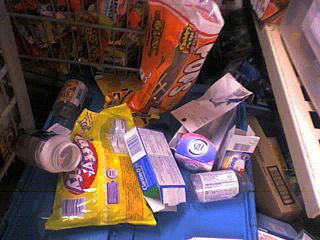Radio-frequency identification (RFID) uses electromagnetic fields to automatically identify and track tags attached to objects. An RFID system consists of a tiny radio transponder, a radio receiver and transmitter. When triggered by an electromagnetic interrogation pulse from a nearby RFID reader device, the tag transmits digital data, usually an identifying inventory number, back to the reader. This number can be used to track inventory goods.

Shoplifting, shop theft, retail theft, or retail fraud is the theft of goods from a retail establishment during business hours, typically by concealing a store item on one's person, in pockets, under clothes or in a bag, and leaving the store without paying. With clothing, shoplifters may put on items from the store and leave the store wearing the clothes. The terms shoplifting and shoplifter are not usually defined in law. The crime of shoplifting generally falls under the legal classification of larceny. Shoplifting is distinct from burglary, robbery, or armed robbery. In the retail industry, the word shrinkage can be used to refer to merchandise lost by shoplifting, but the word also includes loss by other means, such as waste, uninsured damage to products and theft by store employees.
A longbox is a form of exterior paperboard packaging for musical compact discs in widespread use in the 1980s and early 1990s in North America.

A label is a piece of paper, plastic film, cloth, metal, or other material affixed to a container or product, on which is written or printed information or symbols about the product or item. Information printed directly on a container or article can also be considered labelling.
Anti-theft systems protect valuables such as vehicles and personal property like wallets, phones, and jewelry. They are also used in retail settings to protect merchandise in the form of security tags and labels. Anti-theft systems include devices such as locks and keys, RFID tags, and GPS locators.

Retail loss prevention is a set of practices employed by retail companies to preserve profit. Profit preservation is any business activity specifically designed to reduce preventable losses. A preventable loss is any business cost caused by deliberate or inadvertent human actions, colloquially known as "shrinkage". Loss prevention is mainly found within the retail sector but also can be found within other business environments.
Electronic article surveillance (EAS) is a type of system used to prevent shoplifting from retail stores, pilferage of books from libraries, or unwanted removal of properties from office buildings. EAS systems typically consist of two components: EAS antennas and EAS tags or labels. EAS tags are attached to merchandise; these tags can only be removed or deactivated by employees when the item is properly purchased or checked out. If merchandise bearing an active tag passes by an antenna installed at an entrance/exit, an alarm sounds alerting staff that unauthorized merchandise is leaving the store. Some stores also have antennas at entrances to restrooms to deter shoppers from taking unpaid-for merchandise into the restroom where they could remove the tags.
Winners Merchants International L.P is a chain of off-price Canadian department stores owned by TJX Companies.
A store detective is a member of loss prevention whose main role is to prevent and detect theft and reduce shrink in retail outlets. They do this by patrolling the store in plain clothes looking to identify members of the public who are stealing from the store. More common terms today with major retailers are loss prevention agent, detective or investigator and asset protection officer. Special officer, once common, is now rarely used, as few jurisdictions still allow it.
Civil recovery is the method in some legal systems employed to recover the proceeds of crime, instead of, or in addition to, criminal court proceedings.
Property crime is a category of crime, usually involving private property, that includes, among other crimes, burglary, larceny, theft, motor vehicle theft, arson, shoplifting, and vandalism. Property crime is a crime to obtain money, property, or some other benefit. This may involve force, or the threat of force, in cases like robbery or extortion. Since these crimes are committed in order to enrich the perpetrator they are considered property crimes. Crimes against property are divided into two groups: destroyed property and stolen property. When property is destroyed, it could be called arson or vandalism. Examples of the act of stealing property is robbery or embezzlement.

An ultraviolet (UV) marker is a pen whose marks are fluorescent but transparent; the marks can be seen only under an ultraviolet light. They are commonly used in security situations to identify belongings or to prevent the reproduction of unauthorized banknotes. UV pens can now be bought at some stationery shops to securely mark items of high value in case of theft.

In accounting, inventory shrinkage occurs when a retailer has fewer items in stock than in the inventory list due to clerical error, goods being damaged, lost, or stolen between the point of manufacture and the point of sale. This affects profit: if shrinkage is large, profits decrease. This leads retailers to increase prices to make up for losses, passing the cost of shrinkage onto customers.

Package pilferage is the theft of part of the contents of a package. It may also include theft of the contents but leaving the package, perhaps resealed with bogus contents. Small packages can be pilfered from a larger package such as a shipping container. Broader and related aspects of package theft may include taking the entire package, pallet load, truck load, shoplifting, etc. The theft may take place at any point in the parcel's journey from source to destination, including theft by rogue logistics employees and customs agents in international mail scenarios.

An electronic shelf label (ESL) system is used by retailers for displaying, typically on the front edge of retail shelving, product pricing on shelves that can automatically be updated or changed under the control of a central server.
Organized retail crime (ORC) refers to professional shoplifting, cargo theft, retail crime rings and other organized crime occurring in retail environments. One person acting alone is not considered an example of organized retail crime. Working in teams, some create distractions while others steal items judiciously or indiscriminately. Often, they are stocking up on specified items at the request of the organized crime leader.

A booster bag is a handmade bag used to shoplift, typically from retail stores, libraries, and any other location employing electronic security detectors to deter theft. The booster bag can be an ordinary shopping bag, backpack, pocketed garment, or other inconspicuous container whose inside is lined with a special conductive material, typically multiple layers of aluminium foil.
Checkpoint Systems is an American company that specializes in loss prevention and merchandise visibility for retail companies. It makes products that allow retailers to check inventory, quicken the replenishment cycle, prevent out-of-stocks and reduce theft. Checkpoint offers Electronic Article Surveillance (EAS) radio frequency solutions for retail, high-theft and loss-prevention solutions, RFID hardware, software, and labeling capabilities.
Return fraud is the act of defrauding a retail store by means of the return process. There are various ways in which this crime is committed. For example, the offender may return stolen merchandise to secure cash, steal receipts or receipt tape to enable a falsified return, or use somebody else's receipt to try to return an item picked up from a store shelf. Return abuse is a form of "friendly fraud" where someone purchases products without intending to keep them. Perhaps the best-known form of this abuse is "wardrobing" or "free renting" – in which the person makes a purchase, use the product(s), and then returns the merchandise.

In retail, a product return is the process of a customer taking previously purchased merchandise back to the retailer, and in turn receiving a refund in the original form of payment, exchange for another item, or a store credit.









